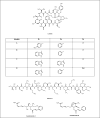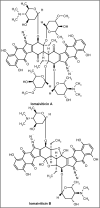Development of antibiotics and the future of marine microorganisms to stem the tide of antibiotic resistance
- PMID: 15600239
- PMCID: PMC4969015
Development of antibiotics and the future of marine microorganisms to stem the tide of antibiotic resistance
Abstract
Antibiotics remain essential tools in the control of infectious diseases. With the emergence of new diseases, resistant forms of diseases such as tuberculosis and malaria, as well as the emergence of multidrug-resistant bacteria, it has become essential to develop novel antibiotics. Development of the existing antibiotics involved three strategies, including discovery of new target sites, modification of existing antibiotic structures, and the identification of new resources for novel antibiotics. Marine microorganisms have clearly become an essential new resource in the discovery of new antibiotic leads.
Figures

















References
-
- Demain AL. Pharmaceutically active secondary metabolites of microorganisms. Appl Microbiol Biotechnol. 1999;52(4):455–463. - PubMed
-
- Walsh C. Where will new antibiotics come from? Nat Rev Microbiol. 2003;1(1):65–70. Review detailing the discovery and innovation of antibiotics. - PubMed
-
- Amabile-Cuevas C. New antibiotics and new resistance. Am Sci. 2003;91:138–149. Review detailing the mechanisms of antibiotic resistance.
Publication types
MeSH terms
Substances
Grants and funding
LinkOut - more resources
Full Text Sources
Medical
Molecular Biology Databases
